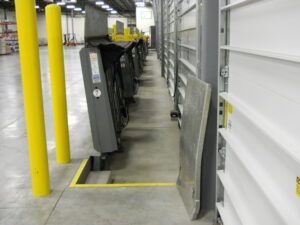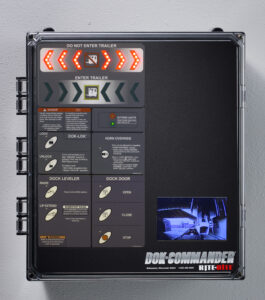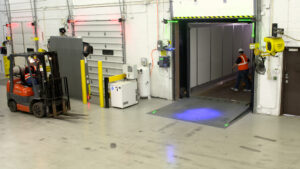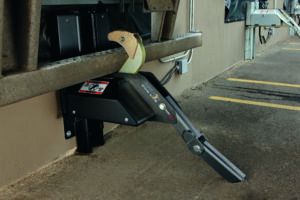The loading dock can be one of the most dangerous parts of any facility, with trailers constantly being loaded and unloaded and forklifts moving heavy pallets amid workers on foot. Unfortunately, loading dock safety precautions in this busy part of the plant are often overshadowed by more obvious hazards inside the plant, such as cutting, welding, and other machining equipment.
 Protecting workers—and the goods and equipment that are part of these processes—is one of the most fundamental aspects of any facility manager’s job, so overlooking loading dock safety can be a fatal mistake. However, by investing in the right loading dock products and dock management software, facilities can seamlessly build safety into their shipping and receiving operations, while also improving productivity. Here’s how:
Protecting workers—and the goods and equipment that are part of these processes—is one of the most fundamental aspects of any facility manager’s job, so overlooking loading dock safety can be a fatal mistake. However, by investing in the right loading dock products and dock management software, facilities can seamlessly build safety into their shipping and receiving operations, while also improving productivity. Here’s how:
Loading Dock Safety Reliability with the Push of a Button
Loading dock products must be equipped or designed to tolerate heavy loads and endure in-plant vehicles such as 3- and 4-wheel forklifts and automated guided vehicles (AGVs)—plus the weight of the materials being transferred—running over it daily. It’s imperative this equipment is sturdy and reliable.
Central to any loading dock operation is the loading dock leveler. This piece of equipment bridges the gap from the facility floor to the bed of a trailer during loading and unloading. Beyond its most basic function as a bridge for forklifts, it should also have safety and ergonomic features built into it. Hydraulic loading dock levelers can be lowered or raised with a push-button instead of workers having to use a pull-chain, which could add long term safety concerns (like back problems) for employees operating this heavy equipment. Levelers that offer a smooth transition from floor to leveler to trailer and back are also preferred, since the “dock shock” caused to forklift drivers by bouncing across poorly designed levelers can cause chronic spinal injuries and other physical problems – not to mention breaking products. For vertical levelers, ideal for drive-through applications, a key consideration is using a sensor that disables the lowering function of the leveler if movement is detected in the pit area. This adds an additional layer of pedestrian safety during leveler cleaning, maintenance, and everyday use.
In addition to the loading dock leveler, it’s important to have a strong vehicle restraint to secure a trailer to the building wall. Operators can engage a vehicle restraint with a trailer’s rear impact guard (RIG) using NEMA 4X controls from inside the plant instead of having to go outside to place unreliable, simple wheel chocks on the potentially dangerous drive approach. Wheel-based restraints can also be an automated operation if the application allows. A properly engaged vehicle restraint can help prevent a host of trailer separation accidents that can lead to a risk to products, equipment, and—most importantly— injuries to material handlers.
Using logistics equipment at the loading dock once required manual labor. Now, when equipment is interlocked into controls, it can be operated with the ease of a button push.
 Interlocking Controls and Safe Sequence of Operation
Interlocking Controls and Safe Sequence of Operation
The development of programmable, interlocking controls at the loading dock adds another layer of safety. By combining the vehicle restraint, dock leveler, overhead dock door, dock barrier, and more, dock controls can be programmed to work only in a safe sequence of operation. This allows facility managers to help prevent accidents due to improper usage—saving facilities money, and costly downtime in the long run.
Integrating multiple loading dock operations into a simple, centralized control system makes it easier for loading dock attendants to perform docking operations safely and quickly. For example, an interlock system disables the use of a hydraulic leveler, overhead door, or dock barrier until the vehicle restraint has achieved a safe engagement.
Eyes Outside – Boots Off the Ground
Advanced loading dock controls can go beyond sensors and offer a live view of the critical safety points on the loading dock exterior. A monitor on the inside of the loading dock, using an exterior camera, can provide a real-time view of the vehicle restraint at the RIG or wheel, as well as at the nose of the trailer. This allows loading dock workers to see if the vehicle restraint has properly engaged with the trailer RIG or wheels, based on which application is used. When equipped with a dual camera, workers inside the loading dock can get a live view of the nose of the trailer to verify trailer stand presence in the case of dropped trailers.
Confirming the vehicle restraint is engaged and/ or trailer stand present eliminates the need for workers to go outside and manually check these products are working properly. In contrast to false alarms from presence-sensing devices, active monitoring from a camera can help keep boots off the ground and help prevent accidents on the drive approach. Additionally, workers might be able to see why a vehicle restraint goes into fault mode instead of having to diagnose the problem while potentially in harm’s way.
As a standalone product, these outdoor cameras and indoor monitor can be incorporated into a loading dock area to provide the same benefits described above.
Clear Communication at the Loading Dock
Red/green interior and exterior dock lights are the most ubiquitous tool for communication and safety at a loading dock. A green light on the control box inside indicates to a forklift that the trailer is locked and safe to enter, while the corresponding red light outside tells the truck driver it is not safe to pull away (and vice-versa). However, these interior lights are not always visible, as stacked pallets can obscure a lift driver’s view. Thankfully, advancements in LED light communication systems have addressed this issue – and more.
Hazard recognition and control systems that incorporate the newest technologies can offer safety solutions inside and outside the loading dock area on the drive approach. This combination of components uses motion detection, line-of-sight notification, and audible alarms to provide hazard recognition and communication to people on and off forklifts. Working in tandem, these safety tools help create a safer, more productive loading dock environment, both inside and outside, by helping keep people a step ahead of the potential dangers in their path.
Outside the dock opening, from a fixed location above the dock door, a sensor detects the motion of a tractor-trailer backing into that dock position. A visual and audible alarm located in the vehicle restraint, or mounted as a standalone box, alerts dock workers on the drive approach of the impending danger. This multisensory alert system is particularly important because ambient noise often masks the sound of a cab’s noisy engine, which can be 70 feet or more from the back of the trailer.
 Inside the dock area, motion-sensing technology can trigger a bright blue light that projects onto the dock leveler when it detects material handling equipment or a pedestrian’s presence inside the trailer. An advanced system also will work in conjunction with the vehicle restraint to alert any dock worker or forklift that enters an unsecured trailer. A blue light emits as an audible alarm alerts the unsuspecting dock worker that they’ve entered an unsecured trailer, while the external light system simultaneously changes to red, warning the truck driver that there is activity inside the trailer. If integrated properly with this safety system, the vehicle restraint cannot be disengaged if motion is detected inside the trailer.
Inside the dock area, motion-sensing technology can trigger a bright blue light that projects onto the dock leveler when it detects material handling equipment or a pedestrian’s presence inside the trailer. An advanced system also will work in conjunction with the vehicle restraint to alert any dock worker or forklift that enters an unsecured trailer. A blue light emits as an audible alarm alerts the unsuspecting dock worker that they’ve entered an unsecured trailer, while the external light system simultaneously changes to red, warning the truck driver that there is activity inside the trailer. If integrated properly with this safety system, the vehicle restraint cannot be disengaged if motion is detected inside the trailer.
Also on the inside of the loading dock are safety lights located just above the upper corners of dock door openings. These LEDs provide a second line of sight to the trailer restraint status in the event control box lights are obscured by pallets. There are also LEDs located in the corners of the leveler to let workers inside the trailer know the trailer restraint’s engagement status, warning them to leave immediately if the restraint becomes disengaged.
While LED communication at the loading dock isn’t new, it’s often a good starting point for any facility that simply has a red light/green light on the inside and outside of the loading dock. Upgrading to smart equipment in this part of the facility today can reap benefits in the future if a move to an Industrial Internet of Things (IIoT) platform is made down the line.
Industrial Internet of Things and Dock Management Software
Getting the right smart equipment at the loading dock can boost productivity while enhancing safety. When connected through dock management software as part of an Industrial Internet of Things (IIoT) platform, loading dock managers can more clearly see the constantly shifting nature of this busy part of the plant.
This focus allows companies to increase energy efficiency, streamline communication, enhance productivity, and monitor events. Real-time and historical safety events can be communicated to safety managers through text and/or email alerts. Through an analysis performed by the IIoT platform, this data helps companies proactively identify trends, training opportunities, and employee behavioral improvement through data-driven decisions.
There are various IIoT platforms able to tap into tremendous amounts of data provided by smart-enabled equipment at the loading dock and inside the plant. Some go beyond capturing data to provide managers with operational insights that help eliminate risky patterns and procedures. Such data analysis can help managers determine if intersections in a facility are becoming too congested or if a mistakenly opened dock door are isolated incidents or recurring problems that need to be preemptively addressed before a devastating accident occurs.
 Achieving a Safer Loading Dock
Achieving a Safer Loading Dock
One of the main goals for any facility is to make it through the day without an injury. While the loading dock is a necessary component for the logistics operation of any successful facility, it can be an area fraught with danger.
However, recent technological advancements made at the loading dock are making it easier than ever to help improve worker safety. Implementing strong and reliable equipment is the first step in delivering a safer work environment. Enhancing that equipment with advanced controls and communication options can even further safety at the loading dock. Taking the next leap into dock management software will bring a new way to streamline communication and operations at the loading dock.
All these loading dock products combine to demonstrate that worker safety and operational productivity truly go hand in hand. After talking with their local loading dock equipment representative, facility managers, and safety managers will be on the right track to help send their employees home safely every day.
About Rite-Hite
Rite-Hite is a world leader in the manufacture, sale, and service of loading dock equipment, industrial doors, safety barriers, HVLS fans, industrial curtain walls, and more – all designed to improve safety, security, productivity, energy savings, and environmental control. Watch Rite-Hite’s Always Looking Ahead video below to learn more.
The information provided herein is provided as a general reference regarding the use of the applicable products in a specific application. This information is provided without warranty. It is your responsibility to ensure that you are using all mentioned products properly in your specific application and in accordance with all laws and regulations.











































